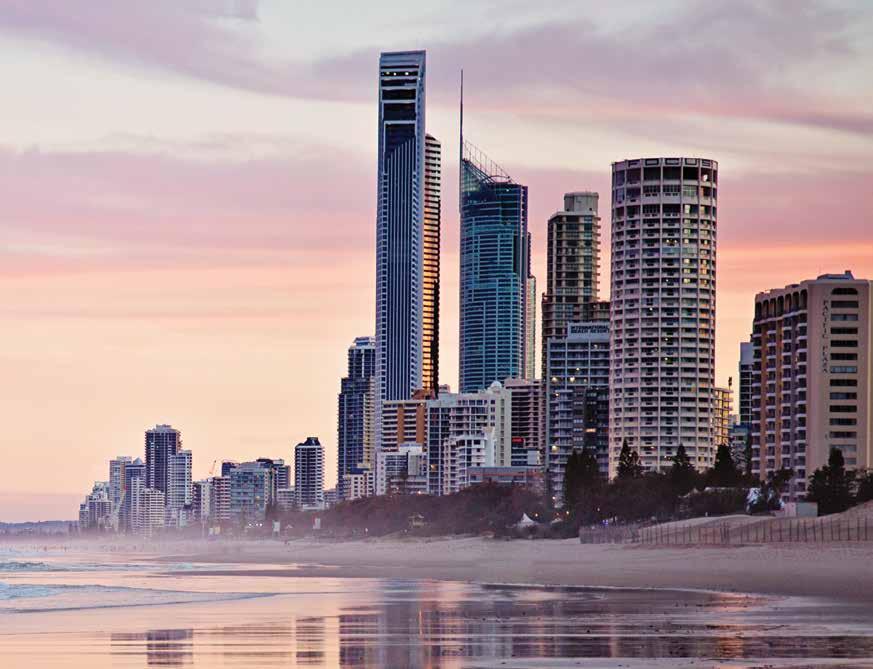
3 minute read
79 Good as Gold
from Cove magazine
GOOD AS GOLD
The rising apartment boom driving the Gold Coast market.
IT’S NO SECRET that the Australian residential property market is currently running hot.
House prices nationally grew at their fastest pace in more than 32 years during March with CoreLogic’s monthly property price index showing a 2.8 per cent gain.
Annual growth is now at 6.2 per cent.
Regional centres rose 11.4 per cent, or well over double the combined growth of 4.8 per cent for the capital cities.
The apartment markets of Sydney and Melbourne are the main weak spots.
Melbourne has the highest rental vacancy rate in the country, weighed down by its inner-city apartment glut.
However, not all apartment markets are created equally.
On the Gold Coast, high demand is exceeding supply.
The latest apartment insights report by consultancy Urbis revealed sales of apartments WORDS NICK NICHOLS
on the Gold Coast were at their highest level in four years in the final quarter of last year.
The research was notable for its finding that buyers were hitting hurdles in a tightening of supply.
While the Gold Coast construction market currently appears to be active, developers actually delivered about a third fewer apartments in 2020 than in 2019.
Urbis identified 22 projects that were underway last year, only slightly down from 24 the year before.
The problem for buyers looking for a foothold in the market is the trend towards smaller, boutique lifestyle developments has created far fewer apartments as a result.
There were just 1411 new apartments built on the Gold Coast last year, down from 2164 in 2019.
With 374 apartments sold in the December quarter, demand is nudging ahead of supply, according to Urbis.
The analysis indicates the Gold Coast has a nine-month supply of apartments, but that doesn’t take into account new projects ready to start.
The numbers anecdotally highlight the unprecedented migration of people from capital cities to regional centres and between regions across Australia.
The Housing Industry Association (HIA) is currently examining this trend and its impact on the industry over the longer term.
“The dynamic has been very difficult to quantify,” says HIA chief economist Tim Reardon.
“It’s certainly one of the factors driving house prices and really tight rental markets at the moment.”
But the latest ABS data shows there is a rapid catch-up taking place.
Australia is in the midst of a new building boom, thanks in part to the federal government’s HomeBuilder grant which has now ended.

The number of dwellings approved nationally in February jumped 21.6 per cent month-onmonth to 19,422, the highest of any month since the ABS began tracking the data in 1983.
This is being led by demand for detached housing.
The HIA has forecast a record 130,000 detached homes will be built Australia-wide this year.
But according to Reardon, the conditions we face now are different to 2018 when a then record of 122,000 homes were built.
He says the demand experienced in 2018 was short of the record number of homes that were being built.
This year demand is running ahead of the HIA’s peak supply target.
While the building boom may ease price pressures in some areas, the Gold Coast faces constraints of its own in delivering detached housing to meet demand.
Due to the state government’s current urban planning framework, the Gold Coast doesn’t have the luxury of wholesale homeand-land development which is putting upward pressure on detached housing values in key infill development areas.
Demand for luxury apartments continues unabated and is pushing developers into a fiercely competitive environment to secure new sites.
Prices of $16,000 per square metre or more are being achieved for detached homes in prime locations along coastal suburbs for multi-storey developments.
The knock-on effect is being felt across the market.
The most recent data from Real Estate Institute of Queensland revealed median house prices on the Gold Coast were up 7.7 per cent in the December quarter and up 6.1 per cent over the year.
The gain over the quarter is the telling figure as it shows an acceleration of price growth for detached houses towards the end of 2020.
Median apartment prices were up 2.1 per cent for the December quarter and 5.5 per cent for the year – an equally solid result.
“Underlying housing demand and strong rental market conditions are likely to see the Gold Coast unit market move into rising market conditions in the short to medium term,” says the REIQ in its latest Queensland Market Monitor report.
The implications of this are that detached housing in central locations on the Gold Coast will continue to perform well as developers eye more infill opportunities to meet that expected demand.










